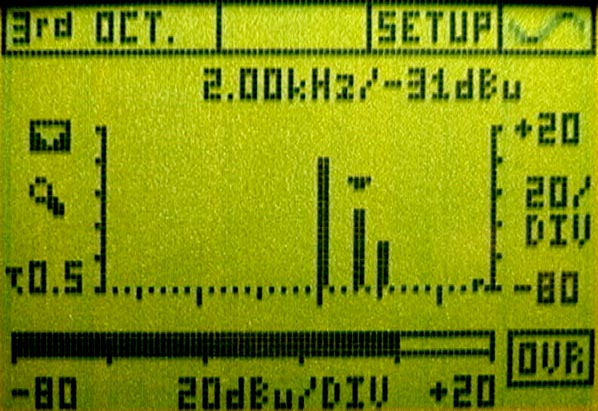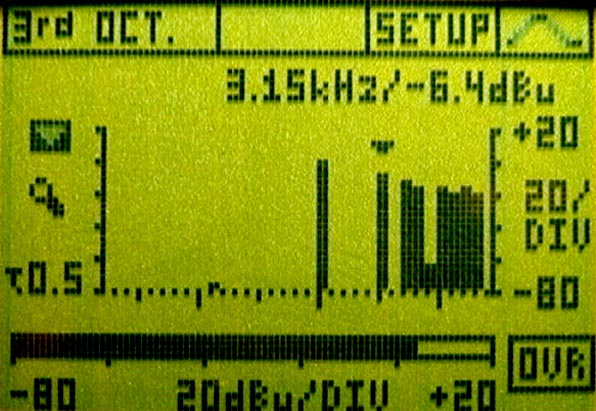- VU+PPM
- POLARITY
- BALANCE
- SWEEP
- 3rd OCTAVE
TESTING MY WORLD
I used the ML1 to measure the THD of two oscillators — the GTC Tone
Plug and the Neutrik MR1 — and two mic preamps — a Great River transformer-less
prototype and an Altec 1566 vacuum tube preamp. The Tone Plug is a handy
"generator in an XLR plug" to be commended for its size, not cleanliness.
Check out Table-1 for the results. While
the Minirator is respectable for it’s price range, to truly measure the
Great River’s performance, a better oscillator would be required. As you
can see, there is almost no difference in the performance of the MR-1 alone
compared to its use with the Great River preamp.
The ML1 emulates three metering standards: mechanical VU meters (referenced to +4dBu), Type-I and "Nordic" Peak Program Meters (PPM, +6 dBu ref) and Type IIA PPM (+8dBu). The user can reconfigure all references. Both VU and PPM are simultaneously displayed. Each includes a numeric Peak Hold indicator, plus there are two Integration Time options: Normal (Type-I and Nordic: 5ms. Type-IIa: 10ms). In FAST mode, the integration time is 1 ms for all standards.
While observing the output of a Panasonic SV-3700 DAT, I immediately
realized that the ML1 could use one additional metering standard capable
of being calibrated to digital audio’s 0dBfs maximum. For example, the
SV-3700 has a –18dBfs nominal reference, the range should should accommodate
a "low" of –20 dBfs and a high of -10dBfs. Neutrik could probably turn
VU+PPM
into a stand-alone stereo product with both analog and digital inputs (and
a larger LCD screen). It would be a helpful mastering tool to see accurate
peak information while maintaining some consciousness of "Volume" as per
the VU meter. The VU meter should not be solidly in the red while the PPM
would be kissing 0dBfs.
The Polarity test requires both the MR1 and the ML1. The MR1 generates a pulse that is easily detected even after travelling through the air. Selecting Polarity on the ML1 engages the input select option — a choice of either the XLR / RCA connectors or the built-in microphone. It works!
Quite unexpectedly, the very first "if only" feature I thought of was an "input balance" indicator — NOT of Left and Right, as this is a MONO box — but of the incoming signals on pin2 and pin3. This feature is a reality on the ML1 putting this gizmo and me on the right foot from the very beginning. A 6dB level problem in the analog world is not uncommon — active balanced outputs can become damaged, or interrupted via dirty patch cord or bad cable — the ML1 will tell which pin isn’t doing its share of the work.
Note: The ML1 "loses" what little headroom it has if the signal
is not precisely balanced. I noticed this when testing the SV-3700, whose
pin2 and pin3 outputs were particularly unmatched, reducing the max headroom
in this case to +19.3 dBu.
Sweep has two options, the traditional RMS Level vs Frequency or Time vs any of the following: Level, THD+N or Frequency. Getting this mode to function was most difficult and the manual was not perfectly clear (perhaps due to translation). I got results simply by copying the example in the manual. Here, a picture was worth a thousand words. The best example would be to plot THD+N to show how distortion increases with increased levels.
The 3rd Octave analyzer can display the audible bandwidth from 20Hz to 20kHz in 31 bands. As mentioned, THD+N does not separate Distortion from Noise. "Harmonic Distortion" is a lack of sonic cleanliness relative to the input signal. Some vacuum tube gear is famous for its pleasing even-order (octave) harmonics. Input 1 kHz, for example, and push the device into its non-linear region (not hard clipping) and watch the — second harmonic (2kHz) pop up as in Figure-1.
 |
 |
|
|
|
- The cursor can be moved to each of the 31 bands to confirm
both frequency and amplitude, the latter in both dB and %. An opamp circuit
in hard clipping will produce odd-order harmonics (square waves are made
from these), the third harmonic to 1kHz is 3kHz. as in Figure-2.
See the Altec preamp specs in Table-1.
- SCOPE
The ML1 will also reveal unrelated content such as hum (fundamental
and harmonics), hiss (the curve will vary with source topology, such as
produced by amplifiers and analog tape recorders), plus the more common
uses of spectrum analysis — the dreaded and completely frightening process
of room / monitor-speaker evaluation.
If you read my article on trouble-shooting bad capacitors using square waves, the "oscilloscope-like" waveform display is the icing on the cake. Of course the perfect companion to the ML1 is the Minirator (the MR-1 is $139.95 @ http://www.mcmelectronics.com) reviewed in the ??? issue and featuring both sine and square waves. As with most LCD scopes, the ML1 does not have amazing resolution, further hampered by the 20kHz bandwidth, which softens square waves until 10kHz looks like a sine wave. That’s ok. About the cost of a cheap-but-real ‘scope alone, the ML1 is much more likely to see active duty, adding credibility to the overused phrase "bang-for-the-buck."
GOOD DADA
Reviewing the ML1 was a good brain exercise, emphasizing the relative ease of making a bad measurement compared to the work involved to acquire good data. That said, after reading this review, the people at Neutrik Test Instrumentsinformed me that an external 20dB attenuator is now available as an optional accessory.
Note-1: This will "pad" the output of the Minirator MR1 — or any oscillator — so that noise measurements would reflect the device under test and not the audio source. It can also pad the input of the Minilyzer ML1 to extend its useful input range.) Otherwise, there is only one flaw. The maximum input of the ML1 is +20dBu, which is not high enough and easily compromised if the signal balance is not perfect.
Note-2: Software updates are also available at the Neutrik Test Instruments web site.
The ML1 is small enough to be kept in a control room or clipped to a belt — for those technicians on the move who are also looking to start a fashion trend. (PDAs might suddenly become less cool!) Consider how many times you’ve returned to the scene of an audio crime only to find no suspects and no problem? Now you can whip out this nifty little "geek tri-corder" whenever a problem occurs. By creating the Minilyzer, Neutrik Test Instruments have given more people the power to troubleshoot. The more you use it, the more you’ll understand that a little science never hurt anyone.
This review was written for the December 2000 issue of MIX. In
the holiday spirit, be a good geek so that you can order both an ML1 and
an MR1 without guild while sitting on the Fat Guy’s Lap. (HINT: Don’t
make any comments about the red suit or the funny smell coming from the
beard.) Then, look forward to a happy stocking hanging from your
mantle bulging with "mini-toyz" on that magic day.
I had too much fun reviewing the ML1 and I'm not giving it back! If I get away with it, you’ll see more cool pictures all over this website.
NTI has a complete line of "expensive" test equipment of the type used by manufacturers, designers and specification certifiers. I believe in this "mini" series from NTI because they provide useful, affordable tools for users who might otherwise not purchase anything. In my goal to make technology more tangible, these tools provide the "link" between an instructive article and the curious end-user.
If, for example, I present an article on distortion, users can now do the same test, step by step with the same equipment. The satisfaction of either confirming a suspicion and finding a problem or knowing that "all systems are go" is comforting. That said, analog audio is easy to troubleshoot compared to digital audio. Learning how to troubleshoot a system and correctly use test equipment are value-added skills. That's why I am looking forward to reviewing the Digilyzer which should be an equally useful aid to unraveling the mysteries of digitized audio.
Your Geek Buddy,
Eddie Ciletti
Click here for more information about this and other Neutrik Test Instruments.